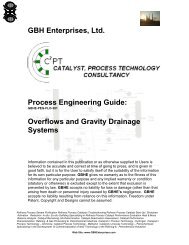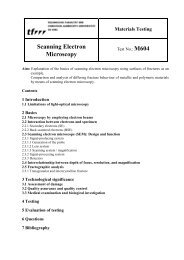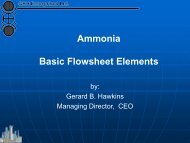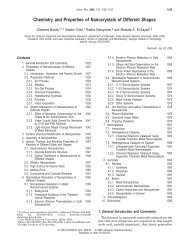Vulcan Series Chloride Removal Technology VGP CRT 2000 and ...
Vulcan Series Chloride Removal Technology VGP CRT 2000 and ...
Vulcan Series Chloride Removal Technology VGP CRT 2000 and ...
You also want an ePaper? Increase the reach of your titles
YUMPU automatically turns print PDFs into web optimized ePapers that Google loves.
4.0 REMOVAL OF CHLORIDES FROM CATALYTIC REFORMER PRODUCT STREAMS<br />
4.1 Introduction<br />
Traditionally chlorides have been removed from catalytic reformer products streams<br />
using fixed beds of adsorbents. For many years alumina has been used as the<br />
adsorbent. Alumina offered a reasonable capacity for chlorides <strong>and</strong> was sold at low<br />
commodity prices.<br />
In recent years alumina users have become more aware of its limitations <strong>and</strong> its<br />
popularity has decreased. The main reasons why alumina limitations have become more<br />
apparent in recent years:<br />
- Analytical techniques have become better <strong>and</strong> are able to detect slip of chlorides from the<br />
alumina beds.<br />
- Recognition that, alumina beds promote the synthesis of organic chlorides which slip<br />
from the bed.<br />
- Higher severity operations (such as CCR <strong>and</strong> cyclic style units) are more common <strong>and</strong><br />
the problems with alumina are particularly noticeable on these units<br />
- Increasing regulations on disposal of spent catalysts has caused problems for users of<br />
alumina.<br />
4.2 Alumina as a chloride guard<br />
To appreciate the limitations of alumina it is first necessary to underst<strong>and</strong> how alumina<br />
removes chlorides. The alumina surface is covered with active sites, which are either<br />
negatively charged hydroxyl groups or positively charged aluminum sites. These polar<br />
sites are capable of attracting polar molecules, <strong>and</strong> the more polar the molecule the<br />
greater the attraction.<br />
Hydrogen chloride is quite polar (dipole moment of 1.08 Debyes) <strong>and</strong> will be adsorbed to<br />
the surface of the alumina. For the more active sites on the alumina there may even be<br />
some disassociation of the hydrogen chloride with the negatively charged chloride<br />
aligning with the aluminum sites <strong>and</strong> the positively charged hydrogen ion being released<br />
from the surface. However, most of the hydrogen chloride is not disassociated.<br />
Thus most of the hydrogen chloride is removed by physical adsorption on the surface<br />
(rather than by chemisorption where there is actually a rearrangement of the electron<br />
structure between the surface <strong>and</strong> adsorbing molecule-taking place). The physisorbed<br />
intermolecular forces are weak <strong>and</strong> sensitive to changes in the operating environment.<br />
The actual concentration of hydrogen chloride at the surface of the alumina is determined<br />
by equilibrium with the hydrogen chloride partial pressure in the gas. This equilibrium<br />
constant is sensitive to changes in:<br />
Refinery Process Stream Purification Refinery Process Catalysts Troubleshooting Refinery Process Catalyst Start-Up / Shutdown<br />
Activation Reduction In-situ Ex-situ Sulfiding Specializing in Refinery Process Catalyst Performance Evaluation Heat & Mass<br />
Balance Analysis Catalyst Remaining Life Determination Catalyst Deactivation Assessment Catalyst Performance<br />
Characterization Refining & Gas Processing & Petrochemical Industries Catalysts / Process <strong>Technology</strong> - Hydrogen Catalysts /<br />
Process <strong>Technology</strong> - Ammonia Catalyst / Process <strong>Technology</strong> - Methanol Catalysts / process <strong>Technology</strong> – Petrochemicals<br />
Specializing in the Development & Commercialization of New <strong>Technology</strong> in the Refining & Petrochemical Industries<br />
Web Site: www.GBHEnterprises.com








